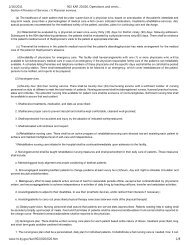State Regulations Pertaining to Dietary Sanitation & Environmental ...
State Regulations Pertaining to Dietary Sanitation & Environmental ...
State Regulations Pertaining to Dietary Sanitation & Environmental ...
You also want an ePaper? Increase the reach of your titles
YUMPU automatically turns print PDFs into web optimized ePapers that Google loves.
stream from the final rinse control valve <strong>to</strong> permit checking the flow pressure of the final rinse<br />
water.<br />
(19) Machine or water line mounted numerically scaled indicating temperature measuring devices,<br />
accurate <strong>to</strong> ±3°F (1.5°C), must be provided <strong>to</strong> indicate the temperature of the water in each tank of<br />
the machine and the temperature of the final rinse water as it enters the manifold.<br />
(20) Rinse water tanks must be protected by baffles, curtains, or other effective means <strong>to</strong> minimize<br />
the entry of wash water in<strong>to</strong> the rinse water. Conveyors in dishwashing machines must be<br />
accurately timed <strong>to</strong> assure proper exposure times in wash and rinse cycles in accordance with<br />
manufacturers' specifications attached <strong>to</strong> the machines.<br />
(21) Drainboards must be provided and be of adequate size for the proper handling of soiled<br />
utensils prior <strong>to</strong> washing and of cleaned utensils following sanitization and must be so located and<br />
constructed so as not <strong>to</strong> interfere with the proper use of the dishwashing facilities. This does not<br />
preclude the use of easily movable dish tables for the s<strong>to</strong>rage of soiled utensils or the use of easily<br />
movable dish tables for the s<strong>to</strong>rage of clean utensils following sanitization.<br />
(22) Equipment and utensils must be flushed or scraped and, when necessary, soaked <strong>to</strong> remove<br />
gross food particles and soil prior <strong>to</strong> being washed in a dishwashing machine unless a pre-wash<br />
cycle is a part of the dishwashing machine operation. Equipment and utensils must be placed in<br />
racks, trays, or baskets, or on conveyors, in a way that food contact surfaces are exposed <strong>to</strong> the<br />
unobstructed application of detergent wash and clean rinse waters and that permits free draining<br />
(23) Machines (single-tank, stationary-rack, door-type machines and spray-type glass washers)<br />
using chemicals for sanitization may be used, provided:<br />
(a) The temperature of the wash water may not be less than 120°F (49°C);<br />
(b) The wash water must be kept clean.<br />
(c) Chemicals added for sanitization purposes shall be au<strong>to</strong>matically dispensed;<br />
(d) Utensils and equipment must be exposed <strong>to</strong> the final chemical sanitizing rinse in accordance<br />
with manufacturers' specifications for time and concentration;<br />
(e) The chemical sanitizing rinse water temperature may not be less than 75°F (24°C) or less than<br />
the temperature specified by the machine's manufacturer;<br />
(f) Chemical sanitizers used must be approved by the EPA;<br />
(g) A test kit or other device that accurately measures the parts per million concentration of the<br />
solution must be available and used.<br />
(24) Machines using hot water for sanitizing may be used provided that wash water and pumped<br />
rinse water must be kept clean and water must be maintained at not less than the temperature<br />
stated below:<br />
(a) Single-tank, stationary-rack, dual-temperature machine:<br />
Page 53 of 74



